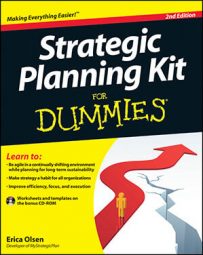While you’re developing a strategic plan for your company, evaluating your ratios against those in your industry provides an objective look at how you’re performing. It helps you determine how other companies similar to yours are doing.
When you have industry numbers to compare your company to, you can see whether you’re performing better or worse than other companies. With that information, you can take corrective action or keep on doing what you’re doing.
For access to industry benchmark sources, check out the following online sources:
BizStats: BizStats is a free online resource that provides industry averages for numerous different ratios.
BizMiner: This site provides reports of financial ratios by industry.
Dun & Bradstreet (D&B): D&B publishes a report called Industry Norms and Key Business Ratios. You can find the link to it online under the site’s Solutions and Risk Assessment sections.
Financial-data services:
The industry (or industries) you operate in have significant impact on your future because underlying forces that you can’t get away from exist in every industry. As you’re identifying your strategic issues, think about what those forces are and what may be changing.
The following categories are evaluated from high to low or growth to decline and provide a quick overview of your industry structure. Complete your own assessment to identify forces and the impact that they could.
Life cycle stage: All industries go through periods of growth, maturity, and decline. An average life cycle lasts 70 years. Maturity is the longest stage at 40 years with growth and decline at 15 years each.
Regulation level: The amount of governmental regulation and policy that supports or prevents company operations can be high, medium, or low.
Revenue volatility: A higher level of revenue volatility implies greater industry risk. Volatility can negatively affect long-term strategic decisions, such as the time frame for capital investment.
Technology change: Technology change is the degree to which technological change impacts continued competitiveness and required capital investments.
Capital intensity: Capital intensity is an indicator of how much capital is used in production as opposed to labor. The level of capital intensity can be high, medium, or low. High is a ratio of less than $3 of wage costs for every $1 of depreciation; medium is $3 to $8 of wage costs to $1 of depreciation; low is greater than $8 of wage costs for every $1 of depreciation.
Barriers to entry: Barriers to entry can be high, medium, or low. High means new companies struggle to enter an industry, while low means a firm can easily enter an industry.
Industry globalization: Industry globalization is an indicator from low to high of how companies are fulfilling production demands and driving down costs. Product companies are likely to feel higher pressure over service companies.
Concentration level: Concentration is identified as high, medium, or low. High means few big players account for the majority of revenue; medium is revenue that’s concentrated in more than a few big players but isn’t fragmented. Low means the industry is fragmented.
Competition level: This level is the degree to which companies compete against each other for customers within the market. Concentration and competition levels tend to follow the same trend from high to low.
Pulling in external research is highly recommended to bring in a third-party view. Resources include IBISWorld, Morningstar, and MarketResearch.com. While all these resources provide fee-based industry reports, the information ensures that you’re not planning in a vacuum and you’re objectively looking at the industry structure.

